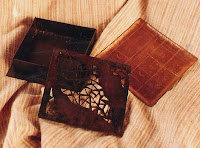Now that you know how to cut, pierce, raise, shape and etch metal , its time to graduate!! :) Time to complete you metal art work, by giving it some really interesting 'finishes' . What are 'finishes' in metalwork , well finish simply refers to the final look of the piece, whether left off with the original warm red of the copper or given and aged look or coloured. Here are some of the more commonly used finishes or effects to make any artwork look interesting.
Copper which is usually the preferred metal for most techniques, also happens to tarnish quite easily, especially so if you live in a city like Mumbai, ( humid and high levels of air pollution).
Copper which is usually the preferred metal for most techniques, also happens to tarnish quite easily, especially so if you live in a city like Mumbai, ( humid and high levels of air pollution).
So in order to protect you pieces and make them more attractive, you can add certain finishes.
 |
| Copper box and dish with antiqued and lacquered finish ©1998 Nayna Shriyan |
- Lacquer or Varnish: If you are like me and love the warm red colour of copper then a clear coat of varnish is all you need to do in order to protect your artwork. Lacquer can either be sprayed on or brushed on depending upon the variety used. I personally prefer the spray on kind that you get in cans, making for a smoother and even coat.The dish shown here on the right is a clear copper effect with lacquer sprayed on.
- Antiqued: If a more aged , antique look is what you are after then, aging the copper is easy with some liver of Sulfur commonly called 'Oxidizing salt' . Generally if the salt is fresh all you need to do is mix a small lump with some water and dip your piece once or twice very quickly, brush with a brass wire brush and rinse (never ever leave your copper sitting in the solution even for a minute!) The box in the picture above is a perfect example of the antiqued effect, it is a very old piece, in fact one of my very first assignments in college!
- Patina: Patina is essentially colour that is bought about chemically upon a metal surface with the use of certain chemicals and under very particular conditions. Technically speaking it is a protective layer formed on the surface of the metal due to atmospheric conditions. There are a range of colours that can be achieved with the right chemicals, from a vibrant blue to a dull rust brown, from green to a blood red, textured straw yellows to black. The simplest of greens can be achieved by applying any acidic substance like lemon juice to a clean piece of metal and then leaving it out for a few hours, you might need to repeat the application and then keep rinsing in between applications. After you have obtained the colour you desire, the piece absolutely has to be waxed in order to be protected. The atmosphere continues to change the colour until most simply turn into a very dull black
 |
| Pendant with irregular blue green patina on copper ©02010 Nayna Shriyan |
So do drop a line if you liked this series and if you have any thoughts regarding another series I could run like this :)



